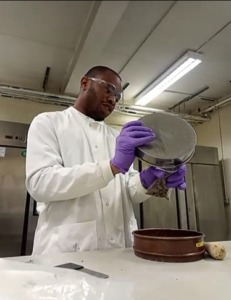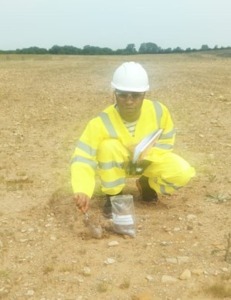Exploring the world beneath our feet!
11/10/2023

Hi readers! I’m Marvellous Christopher Etuk, an environmental engineer passionate about restoring degraded ecosystems through soil science. I recently completed my MSc in Environmental Engineering at Cranfield University in the UK. Through my MSc thesis, I got linked with Hanson, UK who are my sponsors for the project on microbial community structure in restored quarried grasslands. In addition to the data skills in principal component analysis, I have garnered fine skills from field-to-lab experience in visual soil assessment, phospholipid fatty acid analysis (PLFA), microbial biomass, and available nitrogen and phosphorus through this project. These experiences showed me how applied science can develop sustainable solutions tailored to local contexts. As an emerging steward of our shared planet, I’m eager to join mission-driven organizations advancing biodiversity conservation, regeneration, and land restoration. I also hope to continue pursuing research uncovering novel nature-based strategies to add to the pool of scientific bodies and benefit communities.
On this blog, I look forward to sharing my perspectives as an early career scientist. From exploring soil microbiomes to highlighting promising technologies, I aim to make science accessible while driving impact. I believe ecology should empower, not overwhelm us. Let’s grow our wonder for the living world! I’m glad you’re joining me on this journey to dig into our marvellous planet. Let’s get started!
When we think of biodiversity, oftentimes the focus is on larger lifeforms we can see above ground; big animals like elephants or trees probably come to mind. But did you know there’s a whole hidden world of diversity living right beneath our feet?
Inside every spoonful of soil are billions of tiny living things – algae, fungi, bacteria, protozoa. Together, these microscopic soil organisms are called microbiomes. Though invisible to our eyes, soil microbiomes powerfully impact ecosystems and our lives. Much like how COVID brought societies to a halt, soil organisms exert tremendous invisible influence.
Growing up, I learned it’s often the smallest things that have the biggest effects. The fertile soils that grow our food rely on the diversity of microbial communities living symbiotically with plant roots. These microbiomes recycle nutrients, store carbon, unlock essential minerals for vegetation (above-ground biodiversity), and even regulate the entire planet’s climate! Yet modern practices from tillage to pesticides can disrupt these essential partnerships, throwing off natural balances.
Soil microbiomes let ecosystems flourish the way our gut microbiome keeps us healthy. And we’re just beginning to unlock their incredible secrets! Hanson and Ketton Quarry are using innovative tools to study how land management choices impact these communities. Just like how a doctor analyses your microbiome to offer health advice, soil samples help experts recommend steps to restore the habitats of these soil microbiomes. Hanson and Ketton Quarry actively work to conserve and rebuild microbial biodiversity through sustainable land management strategies tailored to local ecology. Recent research by myself and colleagues evaluating quarry restoration sites, particularly at Ketton Quarry found management options ranging from reduced soil disturbance, and seed mixes to organic amendments can help improve belowground diversity.
Here are three simple ways YOU can help conserve these soil microscopic helpers:
- Grow native plants – their roots nourish unique underground species.
- Reduce chemical fertilizers and pesticides – they harm essential fungi and bacteria.
- Limit soil disturbance – tillage and compaction disrupt delicate communities.
By getting smart about belowground biodiversity, we can nourish healthier soils to grow more resilient crops, support carbon storage, and maintain the interconnected web of life. When it comes to conservation, small things count in a very big way! What are you doing to take care of the little things? So, let’s spread the word to get others excited about the tiny ecosystems under their feet with conservation at the forefront!!


Categories & Tags:
Leave a comment on this post:
You might also like…
Keren Tuv: My Cranfield experience studying Renewable Energy
Hello, my name is Keren, I am from London, UK, and I am studying Renewable Energy MSc. My journey to discovering Cranfield University began when I first decided to return to academia to pursue ...
3D Metal Manufacturing in space: A look into the future
David Rico Sierra, Research Fellow in Additive Manufacturing, was recently involved in an exciting project to manufacture parts using 3D printers in space. Here he reflects on his time working with Airbus in Toulouse… ...
A Legacy of Courage: From India to Britain, Three Generations Find Their Home
My story begins with my grandfather, who plucked up the courage to travel aboard at the age of 22 and start a new life in the UK. I don’t think he would have thought that ...
Cranfield to JLR: mastering mechatronics for a dream career
My name is Jerin Tom, and in 2023 I graduated from Cranfield with an MSc in Automotive Mechatronics. Originally from India, I've always been fascinated by the world of automobiles. Why Cranfield and the ...
Bringing the vision of advanced air mobility closer to reality
Experts at Cranfield University led by Professor Antonios Tsourdos, Head of the Autonomous and Cyber-Physical Systems Centre, are part of the Air Mobility Ecosystem Consortium (AMEC), which aims to demonstrate the commercial and operational ...
Using grey literature in your research: A short guide
As you research and write your thesis, you might come across, or be looking for, ‘grey literature’. This is quite simply material that is either unpublished, or published but not in a commercial form. Types ...






